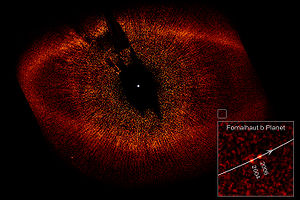
Back قرص حطام Arabic Disc de fragments Catalan Prstenec prašných částic Czech Trümmerscheibe German Disco de basura Spanish خردهقرص Persian Pölykiekko Finnish Disque de débris French דיסקת שברים HE मलबा चक्र Hindi

A debris disk (American English), or debris disc (Commonwealth English), is a circumstellar disk of dust and debris in orbit around a star. Sometimes these disks contain prominent rings, as seen in the image of Fomalhaut on the right. Debris disks are found around stars with mature planetary systems, including at least one debris disk in orbit around an evolved neutron star.[1] Debris disks can also be produced and maintained as the remnants of collisions between planetesimals, otherwise known as asteroids and comets.[2]
As of 2001, more than 900 candidate stars had been found to possess a debris disk. They are usually discovered by examining the star system in infrared light and looking for an excess of radiation beyond that emitted by the star. This excess is inferred to be radiation from the star that has been absorbed by the dust in the disk, then re-radiated away as infrared energy.[3]
Debris disks are often described as massive analogs to the debris in the Solar System. Most known debris disks have radii of 10–100 astronomical units (AU); they resemble the Kuiper belt in the Solar System, although the Kuiper belt does not have a high enough dust mass to be detected around even the nearest stars. Some debris disks contain a component of warmer dust located within 10 AU from the central star. This dust is sometimes called exozodiacal dust by analogy to zodiacal dust in the Solar System.
- ^ Wang, Z.; Chakrabarty, D.; Kaplan, D. L. (2006). "A debris disk around an isolated young neutron star". Nature. 440 (7085): 772–775. arXiv:astro-ph/0604076. Bibcode:2006Natur.440..772W. doi:10.1038/nature04669. PMID 16598251. S2CID 4372235.
- ^ "Spitzer Sees Dusty Aftermath of Pluto-Sized Collision". NASA. 2005-01-10. Archived from the original on 2006-09-08. Retrieved 2007-01-03.
- ^ "Debris Disk Database". Royal Observatory Edinburgh. Archived from the original on 2008-08-10. Retrieved 2007-01-03.
© MMXXIII Rich X Search. We shall prevail. All rights reserved. Rich X Search